#industrialist
Text


rare pair doodles
conehead x ninja x royalguard
fencer x industrialist
#castle crashers#castlecrashers#evilwiz's art#fencer#industrialist#conehead#royalguard#ninja#i dont draw royal guard ever cuz theyre my insane mode nemesis but just for sweets i drwe him
14 notes
·
View notes
Text

Mr. Aldridge 001: Giclee Fine Art Print
KEN ROKO
https://krokoart.etsy.com/listing/713569436
#art#artists on tumblr#giclee#artist#wall decor#ken roko#fine art prints#fine art print#animals#artists#cat#animal#industrialist#haute
4 notes
·
View notes
Text

“The rich industrialist was horrified to find the fisherman lying beside his boat, smoking a pipe.
'Why aren't you out fishing?' asked the industrialist.
'Because I have caught enough fish for the day,
'Why don't you catch some more?'
'What would I do with them?'
'You could earn more money. Then you could have a motor fitted to your boat to go into deeper waters and catch more fish. Then you would have enough money to buy nylon nets. These would bring you more fish and more money. Soon you would have enough money to own two boats... maybe even a fleet of boats.
Then you would be a rich man like me.'
'What would I do then?'
'Then you could sit back and enjoy life!'
'What do you think I'm doing right now?'”
#ideas#my screenshots#screenshot#thoughts#life#change#mindset#growth#art#love#industrialist#capitalism#money#power#happiness#present#enough#rich#enjoy life
2 notes
·
View notes
Text
#OTD in 1798 – Death of United Irishman, Henry Joy McCracken.
“The rich will always betray the poor.” –Henry Joy McCracken
Henry Joy McCracken was a cotton manufacturer and industrialist, Presbyterian, radical Irish republican, and a founding member, along with Theobald Wolfe Tone, James Napper Tandy, and Robert Emmet, of the Society of the United Irishmen.
McCracken was born in High Street, Belfast on 31 August 1767. Proud to belong to two important…

View On WordPress
#1798 United Irishmen Rebellion#Antrim#Belfast#Carrickfergus#Cotton Manufacturer#Founding Member of the Society of the United Irishmen#Henry Joy McCracken#Industrialist#Mary Ann McCracken#Milltown Cemetery#Presbyterian#Radical Irish Republican#West Belfast
9 notes
·
View notes
Text





On 6th June 1838 Thomas Glover was born in Fraserburgh.
For the first six years of his life Glover lived at number 15 Commerce Street in Fraserburgh. His father was the chief coastguard in Fraserburgh, he was English and his mother was A Scot from Fordyce, Banffshire. His father was formerly an Officer in the Royal Navy. Thomas Blake Glover had 6 brothers and a sister. The house no longer remains because it was destroyed after a bombing by the German Luftwaffe Air Force during World War 2.
In 1851 the family moved to a Victorian Home in Bridge of Don in Aberdeen. Upon leaving school Thomas Blake Glover started work for a trading company and was soon travelling the World, becoming a successful trader in weapons and ships. His travels took him to Japan with one of his brothers when they both worked for the tea merchant Jardine, Matheson & Co. during the late 1850s and early 1860s.
During his time in Japan Thomas Glover achieved a great deal. He helped the Samurai to overthrow their military leader, the Shogun. This action helped to restore The Emperor to his throne. This earned Glover the nicknames The Broch Samurai and The Scottish Samurai.
Thomas Glover was also a key part in the industrialisation of Japan. After commissioning three warships to be built at Aberdeen shipyards (including the Jho Sho Maru which was their first iron-clad warship) for the Japanese Navy he formed his own shipbuilding company. This developed into the company Mitsubishi after his bankruptcy in 1870. He remained in the company as a Consultant. He also introduced the first trains to Japan and the first mechanised coal mine. He owned the Takashima Coal Mine and helped found the Kirin Beer Company.
Along with other foreign residents they built and funded the Trinity Episcopal Cathedral at the Minami Yamate hillside in 1862.
While living in Nagasaki in 1863 he built a house on the Minami Yamate hillside which overlooks Nagasaki Harbour. This still remains as the oldest Western style building in Japan. Over 2 million people visit it each year. It is known as Glover House and boasts a stunning garden. It is Japan’s top tourist attraction.
Plans were announced in 2015 for the Aberdeen family home of the Glovers to be turned into a £2m research hub, if this happens it could turn Aberdeen into a mecca for curious Japanese visitors, but sadly I can find no new info on this. However Fraserburgh unveiled a statue of Glover, as a young boy launching a model ship, last June.
12 notes
·
View notes
Text
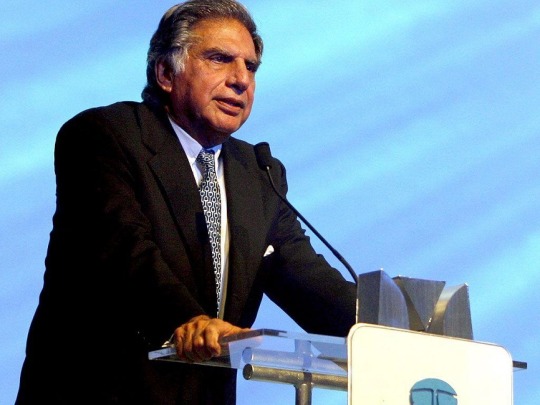
#Luminaries - Ratan Tata
Ratan Naval Tata (born 28 December 1937) is an Indian industrialist, philanthropist and former chairman of Tata Sons. He was a chairman of the Tata Group from 1990 to 2012, and interim chairman from October 2016 through February 2017. He continues to head its charitable trusts.
#gentlemans code#luminaries#Ratan Tata#India#Tata group#industrialist#businessman#corporate executive#manager#corporation#philanthropist#chairman#multinational corporations
2 notes
·
View notes
Photo

Get money on your fingertips!!
CHEQUE BASED PRIVATE FUNDING to expand your business within 4 hours !!
In Delhi NCR starting from 25 Lac to 5 Crore and outside Delhi NCR 1 Crore and above.
Call / Whatsapp
9999609964 , 9958644520
#gthfdelhi#businessloan#jeweller#traders#manufacturer#wholeseller#industrialist#factoryowners#hospital#grocerystore#FMCG#buiders#success#finance#money#importers#exporters#funds#business#instantloan#stockist#privatefunds#petrolpump#delhi
11 notes
·
View notes
Text
#public exhibition#building#construction#plumbingfixtures#plumbing services#plumber services#plumbing#watertreatment#water heater#housing#architectdesign#architecture#modern architecture#sanitation#sanitaryware#pipe supplier#industries#manufacturing#supplier#manufacturer#engineers#industrialist#student#university#study motivation#experience#expertguidance#experimental
0 notes
Text
Charting the Unstoppable Rise of Gautam Adani and the Adani Group
“From Mundra Port to Global Heights”
Gautam Shantilal Adani, born on June 24, 1962, in Ahmedabad India, is an Indian billionaire industrialist with a net worth of over $100 billion and the founder/ chairman of the Adani Group.
Adani Group
Adani Group is an Indian multinational conglomerate, headquartered in Ahmedabad, involved in port development, natural gas, food and infrastructure,…

View On WordPress
#Business#GLOBAL EVENTS#GLOBAL HEIGHTS#Global Impact#GLOBAL MARKET#INDIA#INDUSTRIALIST#Innovation#INNOVATION HUBS#MUNDRA PORT#POLITICAL RELATIONS#POLITICS#TECHNOLOGY#TEXTILE MERCHANT
0 notes
Text
Santa Claus town

Santa Claus Post Office
Santa Claus Town, Indiana, a short article that explains the history and development of this amazing little town, with all its features and touristic link.
“Please be good. Santa is watching!” The sign on the counter of the gift shop essentially sums up the community of Santa Claus, Indiana, a town of 2400 people where Santa is more than a fictional holiday character.
Here, he’s a real figure who permeates every corner of the town. Grocery stores, fast food restaurants, and even liquor stores and doctor’s offices feature the jolly fat guy as part of their name and logo, so he’s watching over you no matter where you go.
Towns with colorful names are not really that unusual in the United States, given the country's geographical diversity and the immense variety of cultures and races that have settled there.
While some of the less savory characters in the nation's vivid history were responsible for putting such places as Tombstone, Cannonball and Dead Man's Gulch, other more tranquil types founded towns with happier names.
The Nativity has inspired many place names in America and one assumes that the intention of these towns forefathers was to bring peace to travelers and residents alike. While today the names of such towns may still soothe the nerves of a long-haul trucker', the places themselves quite often will not.
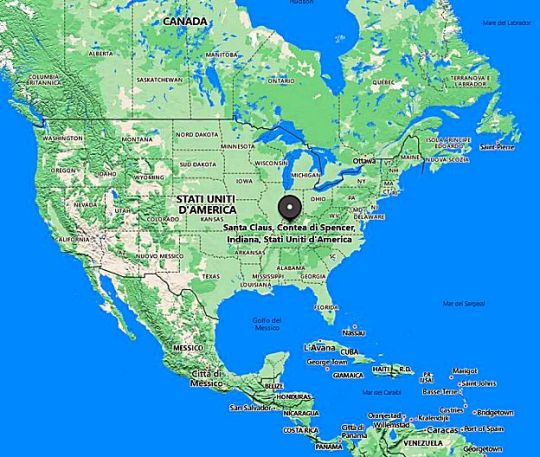
America map
Bethlehem, Pennsylvania, for instance, is a decaying hulk of a steel town; Christmas, Florida is a bustling citrus growing center and tiny Silver Bell, Arizona is just a wide place in the road out on the flats of the Sonoran Desert.
One little hamlet has, however, managed not only to cash in on its holiday handle but to base its entire economy on it as well. Tucked away in the rolling hills of southern Indiana, in the heart of "real" America, is the town of Santa Claus, population 2,600, whose motto is "America's Christmas Hometown".
Santa Claus is a town in Spencer County, Indiana, United States, in the southwestern part of the state. Located in Carter, Clay and Harrison Townships, it sits between Interstate 64 and the Ohio River. The population was 2,481 at the 2010 census, making it the largest community in Spencer County.
The community of Santa Claus was established in 1849. The story of how it received the name of Santa Claus has roots both in fact and legend. In January 1856, the town applied for a post office to be installed. They submitted their application under the name of Santa Fe. The application was returned to them with the message, "Choose some name other than Santa Fe." as there was already a town called Santa Fe.
The process of settling upon the name of Santa Claus has been lost to legend and Several town meetings were held, during which the name Santa Claus was selected. There are many different versions of the story and there were other choices as well that the town did not settle upon. What is known is that in 1856, the name of Santa Claus was accepted by the Post Office Department.
The town has the world's only post office to bear the name of the eponymous Christmas figure. Because of this popular name, the post office receives thousands of letters to Santa from all over the world each year. A group of volunteers known as Santa's Elves ensures each child receives a reply from Santa Claus; this tradition has been in existence since at least 1914.
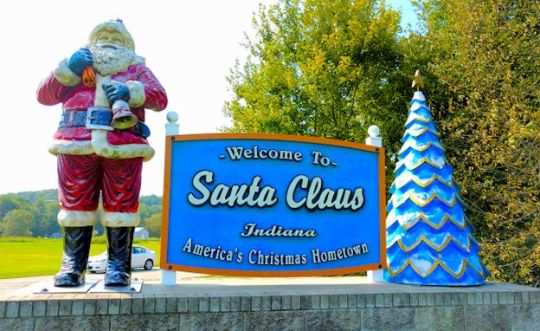
Santa Claus Indiana
Every year, the post office also creates a special Christmas hand-cancellation pictorial postmark for use during December, which also attracts mail from all over the world. The pictorial postmark is chosen each year from submissions from art students at nearby Heritage Hills and South Spencer High Schools.
Local lore has it that the community's first residents had spent most of 1852 trying to come up with a name for the quiet burg, but without success. Then, on Christmas Eve, as the congregation gathered at the church for yet another name-our-town meeting, the sound of bells was heard outside, "Santa!" a jubilant child shouted, "It's Santa Claus."
"That's it!" cried one of the elders'', "Why not call it Santa Claus?" How a group of people who had hitherto refused to settle for a time-honored name like Greenville or Columbus for their clearing in the woods could, all of a sudden, agree to call it Santa Claus remains a mystery to this day. But agree they did and St. Nicholas sobriquet became the eponym for 2,000 acres just north of the Kentucky border.
On June 25, 1895, as part of a nationwide standardization for place names (see United States Board of Geographic Names), the post office name was changed to the one word Santaclaus. The town's unique name went largely unnoticed until the late 1920s, when Postmaster James Martin began promoting the Santa Claus postmark. The name was changed back to Santa Claus on February 17, 1928.
It was then that the Post Office Department decided there would never be another Santa Claus Post Office in the United States, due to the influx of holiday mail and the staffing and logistical problems this caused. The growing volume of holiday mail became so substantial that it caught the attention of Robert Ripley in 1929, who featured the town's post office in his nationally syndicated Ripley's Believe It or Not! cartoon strip.
For the next 81 years, the town remained a quaint rural community, albeit with its own post office. But in 1933, in the depths of the Great Depression, a lawyer from Vincennes, Indiana, Milt Harris, came up with the idea of moving to Santa Claus in order to manufacture decorative sleighs.

Santa's Candy Castle
Successful in his venture, he then built a souvenir shop and other buildings which followed the theme of medieval architecture, thereby taking the first steps towards giving tourist appeal to this uniquely named village. Occupying the other pseudo-medieval buildings were several toy manufacturers who set up displays in them.
The Curtiss Candy Company of Chicago followed suit and used Santa Claus as the site for a full-size candy castle which had simulated candy sticks on the roof. The red-brick Candy Castle is purported to be the first themed attraction in the United States.
Harris' project caught the attention of a rival entrepreneur, Carl Barrett, the Chicago head of the Illinois Auto Club, so during the same period Carl A. Barrett of nearby New Harmony organized a Christmas Day dedication ceremony at a roadside park on a scenic Santa Claus over-look. Barrett unveiled a giant 40-ton statue of Santa Claus dedicated to the children of the world in memory of an undying "love" which, presumably, was Santa's.
Disliking what he called Harris' materialism, Barrett planned his own tourist attraction, Santa Claus Park. On December 25, 1935, Barrett dedicated a 22-foot (6.7 m) tall statue of Santa Claus that was erected on the highest hill in town. The statue was promoted as being solid granite, although it was subsequently revealed to be concrete when cracks formed years later.
Years of lawsuits between Harris and Barrett were costly distractions for the two entrepreneurs. The lawsuits centered around land ownership and went all the way to the Indiana Supreme Court. National news media covered the ongoing story of "Too Many Santas." Over the years, both entrepreneurs' visions became neglected as the development of the town spread west due to land development by the Koch Family.
On August 3, 1946, retired industrialist Louis J. Koch opened Santa Claus Land, which is claimed to be the world's first theme park. The park's name was changed to Holiday World in 1984. In 1993, it became Holiday World & Splashin' Safari when a water park named Splashin' Safari was added to the park. Still owned and operated by the Koch family, it attracts more than one million visitors annually, and it is home to The Voyage, which has repeatedly been voted by coaster enthusiasts as the number one wooden roller coaster in the world.

Santa Claus town history
So even in the desperate aftermath of the nation's economic collapse and with the dark storm clouds of war gathering over Europe, the residents of Santa Claus managed to maintain a cheery disposition that would have made the jolly "old gent" himself proud.
Better times came after the war. In 1945, an Evansville, Indiana industrialist by the name of Louis J. Koch began to build on the 260 acres of rolling farmland that he had recently bought. A man with nine children, he knew what kids liked and the place he was creating was designed to provide fun for all the family. On August 3, 1946, the retired industrialist opened Santa Claus Land, which is claimed to be the world's first theme park.
The park's name was changed to Holiday World in 1984. In 1993, it became Holiday World & Splashin' Safari when a water park named Splashin' Safari was added to the park. Still owned and operated by the Koch family, it attracts more than one million visitors annually, and it is home to The Voyage, which has repeatedly been voted by coaster enthusiasts as the number one wooden roller coaster in the world.
The park, called Santa Claus Land, opened in 1946, bedecked with holiday frippery and filled with goodies straight out of Santa's sack. Designed in Alpine style, Santa's head-quarters included Toyland, a large doll house with more than 1,100 tenants, a play-ground and museum filled with antique and foreign toys, and a selection of the latest models that children could point at as they clambered up onto Santa's knee.
Under the direction of Koch's son, William, Santa Claus Land today boasts such attractions as St. Nick's Nacks, Santa Snacks, Santa's Christmas Tree, the Kris Kringle statue, Rudolph's Reindeer Ranch, the Three Kings Food Fair, Mrs. Klaus' Kitchen and the First Christmas theater.
What's more, Santa Claus Land now forms part of a much larger amusement park called Holiday World. With its sister attractions, Halloween and the Fourth of July, parkgoers can spend every day enjoying the rides, musicals and live shows that make every day a holiday in the little town of Santa Claus.
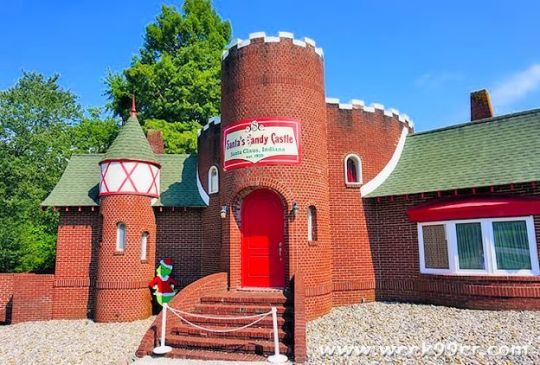
The Santa's castle
Santa Claus has grown substantially since the 1990 census, which recorded 927 residents. A majority of Santa Claus residents live within the gated community of Christmas Lake Village, which was developed in the late 1960s by Bill Koch. It consists of 2,500 acres (10 km2) developed around three lakes: Christmas Lake, Lake Holly, and Lake Noel. The street names in Christmas Lake Village are all named after the Christmas season. Many residents also live in Holiday Village, a subdivision on the north side of town.
Santa Claus is the home to numerous themed attractions including: Santa's Candy Castle, Santa Claus Museum, Holiday World & Splashin' Safari, Frosty's Fun Center, Christmas Lake Golf Course, and Santa's Stables. It is also home to Santa's Lodge and Lake Rudolph Campground & RV Resort.
As of the census of 2000, in Santa Claus there were 2,041 people, 732 households, and 620 families residing in the town. The population density was 393.8 inhabitants per square mile (152.0/km2). There were 818 housing units at an average density of 157.8 per square mile (60.9/km2). The racial makeup of the town was 99.22% White, 0.44% Asian, 0.20% from other races, and 0.15% from two or more races. Hispanic or Latino of any race were 0.69% of the population.
There were 732 households, out of which 39.6% had children under the age of 18 living with them, 79.0% were married couples living together, 4.1% had a female householder with no husband present, and 15.2% were non-families. 12.2% of all households were made up of individuals, and 4.0% had someone living alone who was 65 years of age or older. The average household size was 2.79 and the average family size was 3.05.
In the town, the population was spread out, with 29.3% under the age of 18, 5.0% from 18 to 24, 32.2% from 25 to 44, 24.3% from 45 to 64, and 9.2% who were 65 years of age or older. The median age was 35 years. For every 100 females, there were 95.3 males. For every 100 females age 18 and over, there were 94.6 males.
The median income for a household in the town was $60,388, and the median income for a family was $61,991. Males had a median income of $44,514 versus $24,050 for females. The per capita income for the town was $23,957. About 1.0% of families and 1.2% of the population were below the poverty line, including 1.3% of those under age 18 and none of those age 65 or over.
Holiday

Holiday World Splashing Safary
More recently the development of Christmas Lake Village as a gated community has more than doubled the population of Santa Claus. In 2005, a local development company purchased Santa's Candy Castle and other buildings that comprised Santa Claus Town and announced plans to restore and re-open them to the public, starting with Santa's Candy Castle on July 1, 2006. The 40-ton, 22-foot concrete Santa Claus statue was restored in 2011. And in 2012, a local historic church and the town's original post office were moved to the site next to the large Santa Claus statue.
www.townofsantaclaus.com
santaclausvillage.info
https://www.youtube.com/watch?v=I7d_0m7oICE
https://www.youtube.com/watch?v=eJ5c5Wh0Jr0
Read also our other posts on Christmas
Christmas markets in England
Christmas markets in America
Christmas markets in Italy and Germany
Traditional Christmas Carols ;
Christmas songs
Christmas quotes
60 great Christmas quotes
Christmas tree origin and quotes
Christmas jokes
Christmas cracker jokes
Funny Christmas Stories
Amusing Christmas stories
Christmas food
Christmas thoughts
Christmas story
Christmas in Italy
Christmas holidays
Christmas poems
An Essay on Christmas by Chesterton
Read the full article
#architecture#Barrett#Candy#castle#Christmas#Claus#County#culture#department#Harris#holiday#Indiana#industrialist#Koch#legend#Nativity#Ohio#park#PostOffice#river#Safari#Santa#sleighs#Spencer#Splashing#theVoyage#Tourism#Town#Toyland#UnitedStates
0 notes
Text
Be creative in your approach to funding
#adam molai#entreprenuership#africa#south africa#funding#fundraising#business#economy#manufacturing#industrialist
1 note
·
View note
Text

Sudarshan Venu's Impact: Innovative Leadership at TVS Motor
Sudarshan Venu, industrialist and the Managing Director of TVS Motor Company, stands at the helm of a global powerhouse in the production of two- and three-wheelers. His appointment as Managing Director followed a pivotal board meeting where he showcased strategic acumen and unwavering dedication to innovation. As a visionary businessman, Sudarshan Venu offers a unique perspective, steering TVS Motor Company towards enduring success by leveraging cutting-edge technologies while upholding core beliefs.
0 notes
Text
#finance#riskmanagement#stockmarket#capitalism#futurestrading#speculation#industrialist#upcomingtradera#history#world history
0 notes
Text
#OTD in 1798 – Death of United Irishman, Henry Joy McCracken.
#OTD in 1798 – Death of United Irishman, Henry Joy McCracken.
“The rich will always betray the poor.” –Henry Joy McCracken
Henry Joy McCracken was a cotton manufacturer and industrialist, Presbyterian, radical Irish republican, and a founding member, along with Theobald Wolfe Tone, James Napper Tandy, and Robert Emmet, of the Society of the United Irishmen.
McCracken was born in High Street, Belfast on 31 August 1767. Proud to belong to two important…

View On WordPress
#1798 United Irishmen Rebellion#Antrim#Belfast#Carrickfergus#Cotton Manufacturer#Founding Member of the Society of the United Irishmen#Henry Joy McCracken#Industrialist#Mary Ann McCracken#Milltown Cemetery#Presbyterian#Radical Irish Republican#West Belfast
4 notes
·
View notes
Text

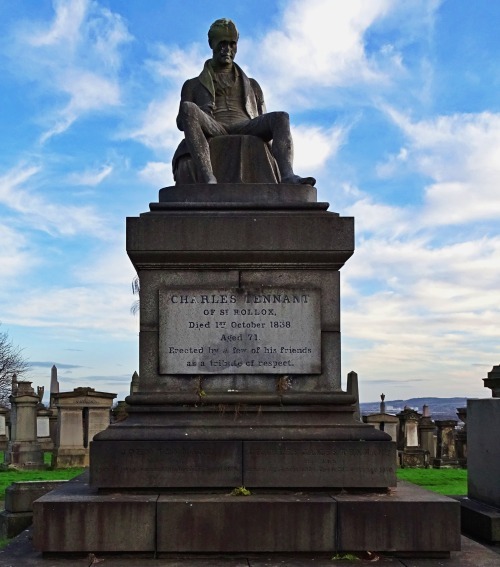
May 3rd 1768 saw the birth of Charles Tennant who became a chemist and an industrialist.
Tennant was born at Laigh Corton, Alloway, Ayrshire to John Tennant and his second wife Margaret McClure. Tennant’s family had farmed there for generations - and had been friends of the local poet Robert Burns. They moved to Glenconner, Ochiltree, Ayrshire, shortly after his birth and Charles attended Ochiltree parish school. After leaving school, he was apprenticed as a weaver.
In his work he saw that the weaving industry was being constrained by the method used to bleach cloth which involved crude chemicals and long exposure to sunlight for many months. He started his own bleaching fields in Ayrshire and looked at the methods used for bleaching. There had already been progress (times had been reduced from 18 months to four) but in 1799 Tennant (in partnership with Charles Macintosh who is best known for his technique of macintosh waterproofing clothing) patented a new method to create a dry bleaching powder that could be used indoors. He built a factory at St Rollox in Glasgow and demand for his bleaching powder soared. By the 1830s and 1840s it was the largest chemical plant in the world, with over 1,000 workers.
Later, he was to become a social reformer, helping to create one of the most productive periods of social progress and reform in Scotland’s history. His works needed large quantities of coal and as he was a good friend George Stephenson, the great railway engineer, Tennant was one of the prime movers in railway expansion. He was mainly responsible for getting a railway into Glasgow. The chemical business founded by Tennant eventually merged with others in 1926 to form the chemical giant Imperial Chemical Industries, that’s ICI, in case you were wondering!
As well as a social reformer they say that he was sharply aware of the atmospheric pollution his works were creating and so he ordered the building of the worlds highest chimney - 450 feet high - in an attempt to lose his fumes into the upper atmosphere. Tennant’s Stack was a Glasgow Landmark well into the twentieth century. Of course pumping it into the atmosphere was doing as much damage up there as it was in Glasgow. I call into question his credentials in this respect as over the decades the St Rollox works has been one of the cities worst eyesores. Chemical waste was dumped in the Sighthill area causing a deadly spread of contaminants through the soil, which local people called the Stinking Ocean. Many of his workers suffered perforated septums and blindness due to continued exposure to toxic chemicals and were colloquially known as ‘Tennant’s White Mice’.
Charles Tennant died suddenly at his home in Abercrombie Place, Glasgow in 1838 aged 71.
Pics are of Tennant, and his grave on the Necropolis.
7 notes
·
View notes
Text
BIRTHDAY: Chief (Dr) Innocent Chukwuma

View On WordPress
0 notes